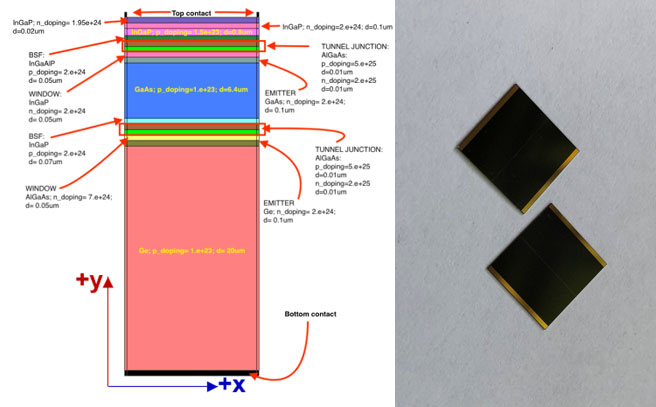Using TFC optical film system design software, a distributed Bragg reflector (DBR) for GaInP / (in) GaAs / Ge three junction solar cells in space is designed. The Bragg reflector composed of 15 pairs of al0.2ga0.8as/al0.9ga0.1as has a reflectivity of 96% at the central wavelength of 850nm, which can effectively reflect the infrared light in the band of 800 ~ 900nm and then be secondary absorbed, The radiation resistance of GaAs sub cells is improved. The basic law of the degradation of electrical parameters of GaInP / GaAs / Ge solar cells with irradiation fluence under 1MeV electron irradiation is obtained through the ground simulated irradiation tests of two cell structures a and B. on this basis, the carrier transport mechanism in the solar cells is analyzed by PC1D simulation program, The basic law of the variation of majority carrier concentration and minority carrier diffusion length with the amount of irradiated electron beam in two battery structures under 1MeV electron irradiation is established. The results show that the majority carrier concentration and minority carrier diffusion length decrease with the increase of incident electron beam, At the same time, the majority carrier removal rate and minority carrier diffusion length damage coefficient in the primary cell structure a are significantly higher than those in the new cell structure B, which shows that the new cell structure with Bragg reflector has stronger radiation resistance.

GaAs solar cells are the main energy source of various spacecraft in space, and are more and more widely used in space. However, solar cells located in space will be irradiated by space particles, resulting in damage in the cells. In this paper, by using the analysis methods of cell current and voltage characteristics, spectral response (EQE), fluorescence spectrum (PL), etc, The radiation damage law of GaInP / GaAs / Ge triple junction solar cell and its sub cell GaAs is systematically studied. The main results are as follows: (1) taking GaInP / GaAs / Ge triple junction solar cell for satellite as the research object, the radiation damage of GaInP / GaAs / Ge triple junction solar cell irradiated by different fluence protons and xenon ions is studied through proton and xenon ion irradiation experiments. The results show that, The degradation of electrical properties of GaInP / GaAs / Ge triple junction battery after high-energy proton and heavy ion irradiation also conforms to the engineering application formula, i_ S _ C vs V_ (OC) presents a more serious degradation behavior, which is mainly due to the series structure of three junction cells. The quantum efficiency test of xenon ion irradiated cells shows that the top cell of the battery is more seriously damaged by heavy ions than the middle cell, which is mainly due to the thicker base region of the middle cell, resulting in the capture of photogenerated carriers in the base region by the recombination center, The photoluminescence test also shows that there is a characteristic peak in the photoluminescence spectrum of the initial state cell at 650 nm. The half peak width of the photoluminescence characteristic peak of GaInP material after irradiation obviously changes, and the peak position obviously shifts to the left when compared with the sample before irradiation, mainly because the lattice integrity is destroyed after irradiation, and some lattice atoms will be irregularly arranged.